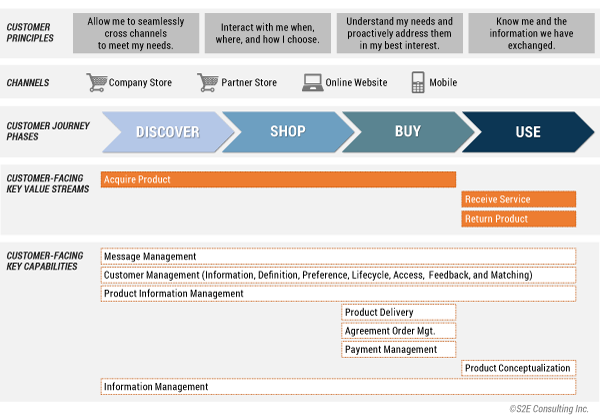B & EA EXECUTIVE UPDATE VOL. 20, NO. 14

In most industries, customer expectations have greatly escalated over time — customers want what they want, how they want it, and when they want it — and they will go elsewhere if their needs are not met. Organizations have responded to heightened customer demands by transforming in various ways: digitalizing the way they deliver products and services, shifting from product-centric business models to customer-centric models, and even reorganizing internally to better serve customers. Within these organizations, it is not uncommon to see leaders and teams purely focused on the strategy, design, and measurement of the customer experience (CX). Disciplines have even formed related to CX and service design, delivering artifacts such as journey maps, service blueprints, and customer personas.
The emergence of CX design as a key discipline practiced by many organizations has opened up some questions about how it relates to business architecture. This Executive Update provides an overview of the benefits and integration points between CX design and business architecture, two mutually beneficial disciplines, both critical to customer centricity and transformation.
The Relationship Between CX Design and Business Architecture
Customer experience design and business architecture are two separate disciplines, each with different goals, focuses, artifacts, and team members. However, they both greatly benefit from close collaboration with each other to design, improve, and implement the experience that an organization delivers to its customers. A Business Architecture Guild® white paper on the integration of these two disciplines describes it as follows:
Through the combination of business architecture and customer experience design, organizations will gain more insight as to where and how to align and transform their business models in order to focus on the ongoing needs of their customers while driving organizational efficiencies. This alignment will lead to business architecture practitioners and customer experience teams working hand in hand, helping to shape and evolve the business architecture, which will create maximum customer and business value.
Simply stated, business architecture translates CX designs1 (new ones or revisions to existing ones) into the changes necessary to the business and IT environment to make them real, and packages those changes into a coordinated set of initiatives for execution.
To put this relationship into an enterprise context, Figure 1 shows an end-to-end perspective on strategy execution. In Stage 1, both the CX design and business architecture teams inform and consume the organization’s strategies as they are formulated. Once finalized, in Stage 2, the CX team (informed by the business architecture team as applicable) designs or modifies the customer experience as needed to reflect the strategy. The business architecture team then translates both the strategies and the CX designs into the specific changes required for business architecture capabilities and value streams.

Figure 1 — An enterprise perspective on strategy execution.
From the intersection of these two domains, all other changes to the business and IT environment can be identified. Based on the collective set of required changes, together with IT architects, the business architecture team produces a target business and IT architecture(s) that the organization can work toward. In Stage 3, they organize the business and IT changes necessary to achieve the target architecture(s) into the most effective set of initiatives with nonoverlapping scopes, which are logically sequenced and reflective of dependencies and integration points. These initiatives are then input into the portfolio management process. Once funded, in Stage 4, business and IT initiatives can begin executing, and their success is measured in Stage 5.2
Benefits of CX Design and Business Architecture Collaboration
The CX design and business architecture teams receive mutual benefit from working with each other. For example, the CX design team benefits business architects by:
-
Articulating a comprehensive vision of the organization’s target customers and end-to-end customer experience
-
Providing clear direction and priorities related to customer needs
-
Serving as a focal point for decision making and governance for customer-facing capabilities and value streams3
-
Identifying gaps or areas for improvement in business architecture related to current or future customer needs
On the other hand, the business architecture team benefits CX designers by:
-
Informing CX design plans based on what is currently in place or planned for, per the business architecture
-
Providing an enterprise-level framework, describing what the organization does at a high level, which can be used as a foundation for identifying and planning customer automation and digitalization
-
Translating customer needs into logically structured initiatives that will deliver them, harmonized with related changes across the enterprise
-
Establishing a common business vocabulary, applicable across all business units
Cross-Mapping CX Design and Business Architecture
There can and should be a direct relationship (or “cross-mapping”) made between the artifacts produced by the CX design and business architecture teams. One of the most common and beneficial approaches is to cross-map customer journeys (at the phase level) to value streams and capabilities. For each customer journey phase, it is ideal to have traceability to the value stream stages (located in one or more value streams) and the capabilities within those stages that apply. This provides the highest degree of specificity to pinpoint how a customer journey is operationalized and to facilitate impact analysis when changes are made to either the journey or any part of the business architecture.
Figure 2 shows a simplified, conceptual view of this cross-mapping for a retail organization, where each phase of the customer journey is mapped to the applicable customer-facing value streams and capabilities. (Note: the figure does not show the cross-mapping between value stream stages and capabilities, though this would ideally be captured in a knowledgebase.)

Figure 2 — Customer journey and busines architecture relationships (a retail example).
Cross-mapping customer journeys to business architecture value streams and capabilities helps to:
-
Demonstrate the importance of the relationship between the two disciplines to other people, especially when visuals such as the example in Figure 2 are publicly available
-
Provide additional context for each discipline’s artifacts (e.g., to show business architecture in the broader customer context and to show the business architecture aspects that operationalize the customer journeys)
-
Validate that the business architecture contains (or will contain) all pieces necessary to enable the current and future customer experience
Moving Forward Toward Collaboration
While both CX design and business architecture teams are increasingly common and provide significant value, they may not exist in every organization. If one or both do not exist, they should be established — provided that the value proposition, advocacy, and resources are in place to support them. Once both are in place, there are a few straightforward steps that CX design and BA teams can take to begin collaborating:
-
Build a relationship and start working together. The first step is to get to know the other team: what they do, who works on the team, how they work, and what their priorities are. This can lead to discussions about integration points, inputs/outputs, and opportunities to work together. As opportunities arise, take them and start working through the process.
-
Cross-map artifacts. At any point in time, begin cross-mapping customer journeys to business architecture value streams and capabilities. This information will need to be kept up to date in a knowledgebase(s) and potentially expanded over time. Share visuals of the cross-mappings with others.
-
Realign roles and processes. After some time working together, it is possible that areas of potential overlap or improvement may be identified, as they pertain to the responsibilities, activities, or artifacts provided by each team. For example, certain CX design approaches and templates define operating model details (e.g., people, process, procedures, and technology) or initiative ideas. In contrast, the business architecture team should identify these types of changes through the translation of the strategy and CX design, taking into account the full picture across the enterprise. In this case, the CX designer’s responsibility would shift from defining initiatives to informing the BA team about them.
Customer experience design and business architecture are arguably two of the most critical disciplines for helping organizations transform for customer centricity and digitalization, as together they define the end-to-end customer vision and make it real in the business and IT environment. Both gain mutual benefit by working together and allow the organization to serve customers in the best possible way, while also operating effectively.
Endnotes
1This Update refers to customer experience design with an emphasis on the external individuals or organization served, but the discipline can also be practiced as experience design, which focuses on the experiences of both external customers and other internal stakeholders.
2For more information on the strategy execution lifecycle, see my Update “A New Vision for Strategy Execution.”
3This responsibility typically requires a group of leaders who serve as final decision makers, not just the CX design team.



